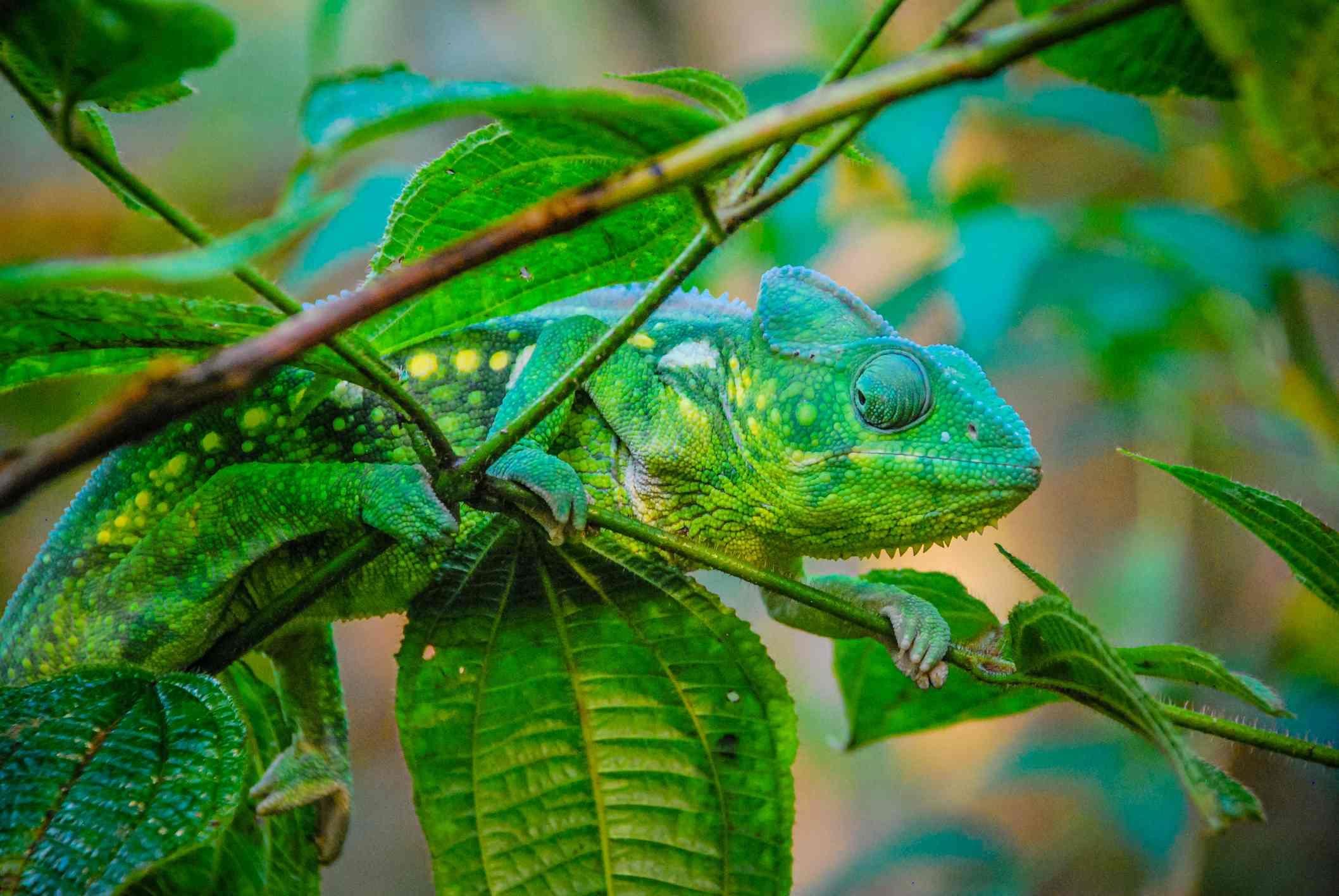Class 4 Science - Adaptation in Animals - CBSE Worksheets Solutions - 1
Q1: Give two examples of the following.
(i) Animals in aquatic habitat _______________ _______________
Ans: Fishes, crabs.
Crab
Aquatic Animals are the animals that live in water. Crabs, turtles, ducks, fishes etc. are some examples. Most of them breathe through gills.
(ii) Animals in polar region _______________ _______________
Ans: Polar bear, Arctic fox
Polar Bear and Arctic FoxAnimals in the polar region are adapted to the extremely cold climate by having some special characteristics such as white fur, strong sense of smell, a layer of fat under the skin, wide and large paws for swimming and walking, etc.
(iii) Animals that live on trees _______________ _______________
Ans: Monkeys, squirrels
MonkeysExamples of such animals include chameleons, lizards, green tree pythons, tree snails, koalas, squirrels, cats, monkeys etc. these animals live on trees.
(iv) Feature for protection _______________ _______________
Ans: Different body covering. Strong legs, camouflage
Organisms have to adopt all the harsh conditions of the environment, in order to live and reproduce. Apart from the harsh environmental conditions like high and low temperatures, little or lots of water etc. A major struggle of the animals is for food. Many of the animals have adopted special features that help them to protect themselves from enemies.
(v) Parasites _______________ _______________
Ans: Worms, lice, ticks, mosquitoes, etc.
A plant or an animal organism that lives in or on another and takes its nourishment from that other organism.
Q2: Multiple Choice Questions (MCQs).
(i) Which of the following is an adaptive feature of a penguin?
(a) Strong legs
(b) Thick skin
(c) Gills
(d) Fur on body
Ans: (b)
PenguinsPenguins have thick skin with a layer of blubber that keeps them warm in cold environments. This insulation helps them survive freezing temperatures. The other options (strong legs, gills, and fur) are not adaptive features for penguins.
(ii) Which of the following is habitat of a cow?
(a) Desert
(b) River
(c) Tree
(d) Open land
Ans: (d)
Cows in open landCows are domesticated cattle and they can survive in a variety of habitats including the grasslands and other habitats where they have enough vegetation to eat.
(iii) ______ is an arboreal animal.
(a) Opossum
(b) Cat
(c) Lion
(d) Tiger
Ans: (a)
Arboreal animals are those animals that spend most of their life on trees. They feed, travel, play, and sleep on trees.
(iv) Which of the following is not a feature for protection?
(a) Shell
(b) Horn
(c) Wings
(d) Scales
Ans: (c)
- Rhinoceros and wild bedfellow when confronted with their enemy stand and fight them. They use their horns while fighting.
- Many animals such as tortoise, turtle, snail, crab have hard outer covering on their body known as shell. This shell protects their soft body parts from injury and also from the attack of the enemies.
- Thick, prickly scales on a reptile can help protect it from predators.
(v) ______ have a combination of tearing, biting and grinding teeth.
(a) Herbivores
(b) Carnivores
(c) Omnivores
(d) Parasites
Ans: (c)
Omnivores, because they eat both meat and plants, have a combination of sharp front teeth and molars for grinding.
Q3: Read the clues and guess the answers.
(i) This animal lives in a burrow
Ans: Rabbit
Different kinds of animals make different kinds of burrows. Lots of mammals make burrows. Some mammals that make burrows are moles, rabbits, and kangaroo mice. The biggest mammal that makes a burrow is the polar bear.

(ii) It has fins and it breathes through gills
Ans: Fish
Fish live and breathe under water. They have scaly skin, fins to help them swim and they breathe through gills.
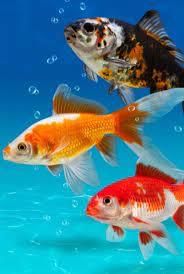 Fishes
Fishes
(iii) This is a bird but cannot fly
Ans: Ostrich
It may seem strange that among the more than 10,000 bird species in the world today is a group that literally cannot fly or sing, and whose wings are more fluff than feather.
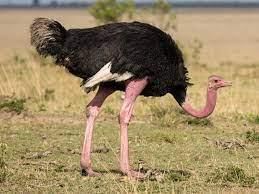 Ostrich
Ostrich
(iv) It has moist skin and can live both in water and on land
Ans: Frog
Animal which live both on land and in water are called amphibians. Examples are Frogs, Crocodiles and tortoises.
Q4: True & False.
(i) Adaptation helps an animal to live uncomfortably.
Ans: False
Adaptations are the special features that help a animal to survive in its habitat.
(ii) The animals that live in cold places have a thick fur on body.
Ans: True
Animals living here have fur on their bodies to protect them from cold. Penguin and polar bear have a thick layer of fat called blubber under their skin to keep them warm.
(iii) Leech is a parasite.
Ans: True
Leeches are not the only animal that feeds on the blood of animals. All these feed on larger animals – but don't kill them, so they are all called parasites.
(iv) The Arctic fox can change its colour.
Ans: True
The arctic fox changes color every six months. Because its coat changes from white in winter to tawny brown in summer, the fox blends in perfectly with the pack ice and the tundra.
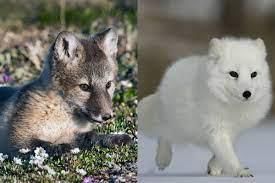
(v) All animals can camouflage themselves.
Ans: False
Camouflage is a type of coloration or pattern that helps an animal blend in with its surroundings. It is common among invertebrates, including some species of octopus and squid, along with a variety of other animals.
Q5: Match the Following.
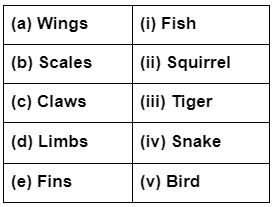 Ans: (a) Wings - bird
Ans: (a) Wings - bird
The bird's wing is a paired forelimb in birds. The wings give the birds the ability to fly, creating lift.
(b) Scales - Snake
Snakes, like other reptiles, have skin covered in scales. Snakes are entirely covered with scales.
(c) Fins - fish
Fins: Help a fish move. The top fins are called dorsal fins.
(d) Limbs - tiger
The four legs have pads similar to those of domestic cats, which allow them to stalk their prey silently. White tigers have pink pads.
(e) Claws - squirrels
Squirrels need their claws for everyday tasks. They grip using these sharp claws, they leap from tree to tree using these claws, and they use their claws to grip and hold their bodies up when climbing.
Q6: Answer the following questions in brief.
(i) What are terrestrial animals?
Ans: Terrestrial animals are animals which live on land. These animals have developed specific features that help them to survive and live on land. Most of these animals have legs, which help them to run fast.
(ii) Define camouflage. Explain how camouflage is useful to Arctic fox.
Ans: Camouflage is a phenomenon in which an animal's body colour merges or blends with their surroundings. This makes it very difficult for the enemy to spot. The chameleon, a lizard-like animal, can also change the color of their skins to match their surroundings.Crypsis is a form of camouflage that helps animals avoid being seen at all. The arctic fox uses crypsis to hide from predators like polar bears, and to also sneak up on its favorite prey-lemmings.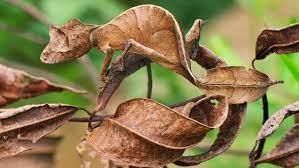
(iii) Explain some adaptations in animals living in Polar Regions.
Ans: Animals in polar regions have adapted to survive in these extreme conditions. They have thick fur or feathers, blend in with the white snow, or hibernate during the coldest winter months.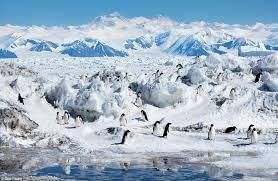
(iv) Differentiate between arboreal animals and aerial animals.
Ans:
- Animals that live on trees are called arboreal animals, while animals which fly are called aerial animals.
- Most birds can fly and so even though they live on trees like arboreal animals, they are aerial animals.
- Examples of arboreal animals include chameleons, lizards, green tree pythons, tree snails, koalas, squirrels, cats, monkeys, parrots, sloths, and a variety of insects. Eagles, kingfishers, pigeons, and Albatrosses are some examples of aerial birds. Butterflies, wasps, and fruit flies are some examples of aerial insects.
(v) What is migration? Name any three animals that migrate from their original place.
Ans: The movement of animals from one region to another to adapt to climatic conditions and to breed well is termed Migration.
Examples: Siberian Crane, Seagull, White Stork, Alaskan Duck, etc.
|
49 videos|156 docs|34 tests
|
FAQs on Class 4 Science - Adaptation in Animals - CBSE Worksheets Solutions - 1
| 1. What is adaptation in animals? |  |
| 2. Why do animals need to adapt? |  |
| 3. Can you give examples of animal adaptations? |  |
| 4. How do adaptations help animals in their environment? |  |
| 5. Are all adaptations permanent? |  |

